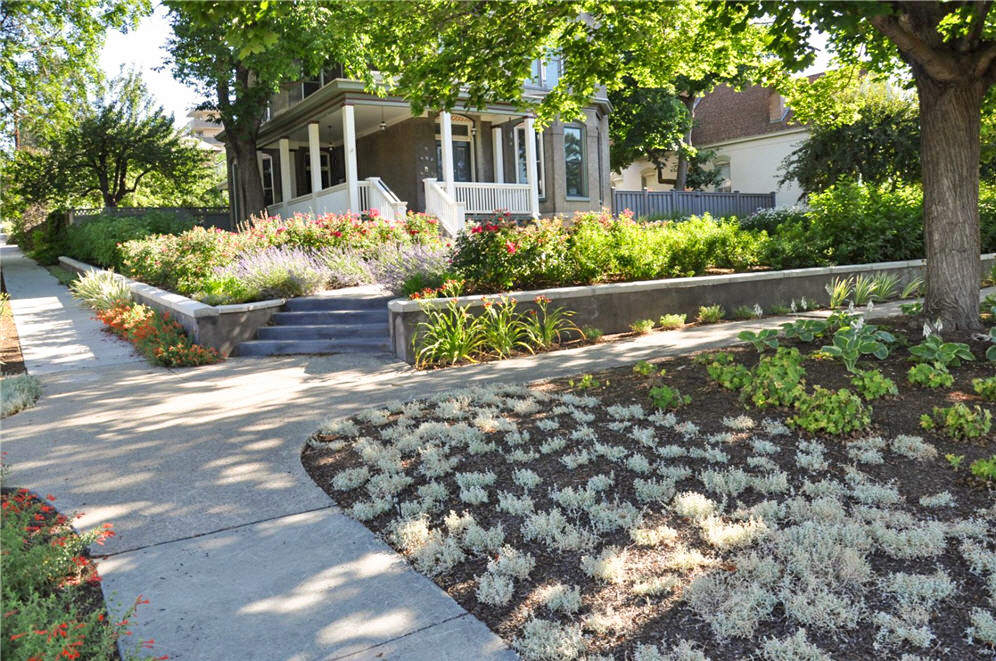
Salt Lake City
Landscaping & Buffers Standards
Salt Lake City’s landscaping and buffer rules focus on a few goals:
- Saving water
- Making the rules easier to understand
- Cleaning the air
- Protecting and planting more trees
- Lowering temperatures in the city
- Reducing stormwater runoff
- Protecting water quality
Our rules require landscaping in certain parts of each property.

Artificial turf is not allowed in areas that require landscaping.
If you installed artificial turf before March 5, 2024, enforcement of artificial turf will be delayed until September 18, 2025, after this time, all landscaping rules must be followed.
Why isn’t Artificial Turf Allowed in These Areas?
Salt Lake City banned artificial turf in certain areas in 1995. Here’s why:
- It traps heat and makes neighborhoods hotter.
- It doesn’t absorb water, which increases the risk of flooding.
- It releases microplastic and harmful chemicals like PFAS that can end up in rivers, lakes, and drinking water.
But there are a lot of other options that are water wise and easy to maintain!
A few alternatives include:
- Creeping thyme
- Tall fescue
- Buffalo grass
- Clover
- Hardscape paths like concrete or crushed rock
You can order low-water grass seed from Public Utilities.
Salt Lake City Plant List & Hydrozone Schedule.
Salt Lake City Landscape BMPs for Water Resource Efficiency & Protection.
Salt Lake City Northwest Quadrant Plant List
Frequently Asked Questions
What are the main goals of the updated Landscaping & Buffers standards in Salt Lake City?
The rules were updated to make the guidelines easier to understand. Salt Lake City’s standards are designed to save water, clean the air, protect trees, keep urban areas cooler, and reduce water runoff after storms. Each rule helps reach these goals while also considering the environment and what the community wants.
Where do the Landscaping & Buffers standards apply in Salt Lake City?
The rules apply to all properties in Salt Lake City. In most cases, they focus on the park strip and the front or corner yard. Some areas may have extra rules based on their zoning.
Why is artificial turf prohibited in required landscaping areas?
Even though some people think artificial turf is easier to maintain, the City Council banned it in required landscaping areas. This is because it makes the area hotter, increases water runoff, uses more water over time, and pollutes our water with microplastics and harmful chemicals.
When was artificial turf prohibited?
1995
How do these landscaping updates impact property owners in Salt Lake City?
Any changes to landscaping in required areas must follow the updated standards. For example, when a traditional lawn (commonly a Kentucky Bluegrass mix) is replaced, it must be with a drought-tolerant alternative. New construction of a residential building in Single- and Two- Family Zoning Districts must meet all landscaping rules. Multi-family, commercial, and manufacturing properties also have to follow the updated rules when changing required landscaping areas.
What are the specific landscaping standards for park strips and front/corner yard areas in residential districts?
Park Strip: Requires at least one street tree in park strips wider than 36 inches, 33% vegetation coverage (including tree canopies), a clearance of 7 feet above the sidewalk and 10 feet above the street, and prohibits traditiona turf. Paving materials and rock mulches are limited to 20% of the park strip area.
Front/Corner Yard Areas: Requires at least 33% vegetation coverage (including tree canopies), limits turf to 33% of the yard area, and prohibits turf in areas less than 8 feet in dimension or on slopes greater than 25%. Hard surfaces and rock mulch are limited to 20% of the yard area.
When is a landscape plan required?
A landscape plan is needed for any new building or primary structure. You also need a plan if you add to, expand, or change the property in a way that makes the building 50% bigger, adds 50% more parking spaces, or changes the landscaping by 50% or more. Single-family and two-family homes do not need to follow this rule.
What are the key components of a complete landscape plan?
A complete landscape plan must include a planting plan, a summary table specifying landscaping area coverage, a grading plan, and an irrigation plan. The planting and irrigation plans must be signed by a Landscape Architect licensed with the State of Utah or an USEPA WaterSense certified professional. Specific details for each plan are listed in the original source.
How do I ensure my completed landscaping complies with the approved plan?
Before you can get a Certificate of Occupancy, you must submit a letter to the City. This letter needs to be signed by a licensed Landscape Architect in Utah or a US-EPA WaterSense certified professional. The letter must confirm that the landscape was installed as it was approved in the building permit.
If you have further questions about landscaping code and requirements contact the Planning Division.